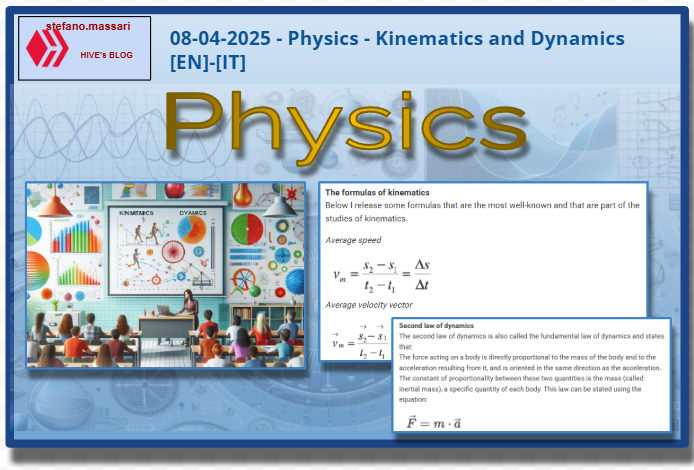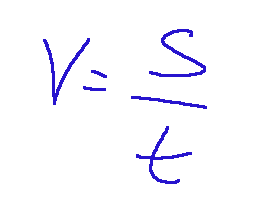
~~~ La versione in italiano inizia subito dopo la versione in inglese ~~~
ENGLISH

08-04-2025 - Physics - Kinematics and Dynamics [EN]-[IT]
With this post I would like to give a brief instruction about the topic mentioned in the subject
(code notes: X_82-81)
Kinematics and Dynamics

image created with artificial intelligence, the software used is Microsoft Copilot
Introduction
Kinematics is a branch of mechanics that studies the motion of objects without considering the causes that produce it.
Kinematics is the science that focuses on the description of movement in terms of position, velocity and acceleration over time.
Fundamental quantities of kinematics
Position (x,y,z)
Velocity (v)
Acceleration (a)
Below are the types of motion studied in kinematics: Rectilinear motion, Curvilinear motion, Harmonic motion.
The formulas of kinematics
Below I release some formulas that are the most well-known and that are part of the studies of kinematics.
Average speed

Average velocity vector

Speed instant

Average acceleration

Acceleration snapshot

It should be noted that velocity and acceleration are both derived quantities:
-Unit of measurement of velocity (S.I.) = m/s
-Unit of measurement of acceleration (S.I.) = m/s2
Uniform rectilinear motion
Uniform rectilinear motion is the motion of a material point that follows a rectilinear trajectory with constant velocity.

Uniformly accelerated rectilinear motion

Plane motions
Plane motions are those types of motion that occur within a plane, or in two dimensions. The description of motion is therefore reduced to the analysis of two coordinates (𝑥 and 𝑦) that change over time, without the need to consider a third dimension. An example of plane motion is the motion of a projectile.
Dynamics

image created with artificial intelligence, the software used is Microsoft Copilot
Dynamics is the branch of mechanics that deals with studying the relationship between forces and the effects they cause on a body.
In dynamics, a body is a point-like body (material point) with mass but negligible shape and dimensions.
The main physical quantities used in dynamics are:
MASS
The mass of a body expresses inertia, or its resistance to motion. It is also called inertial mass.
FORCE
Force expresses an action that causes the variation of motion or state of rest of a body.
Isaac Newton (1642 - 1727) was certainly one of the scientists who made a significant contribution to dynamics. We owe the first principle of dynamics to him, as well as the fundamental law of dynamics and the Principle of action-reaction.
First principle of dynamics
The first principle of dynamics also called the principle of inertia, states that:
If no forces act on a body or a system of forces in equilibrium acts, the body persists in its state of rest or uniform rectilinear motion. A system of forces in equilibrium means a set of forces, vector quantities, whose vector sum is zero.
Second law of dynamics
The second law of dynamics is also called the fundamental law of dynamics and states that:
The force acting on a body is directly proportional to the mass of the body and to the acceleration resulting from it, and is oriented in the same direction as the acceleration.
The constant of proportionality between these two quantities is the mass (called inertial mass), a specific quantity of each body. This law can be stated using the equation:

where 𝐹 is the resultant of the forces acting on the body, m is the mass of the body, and 𝑎 is the acceleration to which it is subject (scalar product by a vector)
Third law of dynamics
The third law of dynamics is also called the action-reaction principle and states the following:
If two bodies interact with each other, two forces develop, commonly called action and reaction: as vector quantities they are equal in magnitude and direction, but opposite in direction.
Conclusions
When we talk about dynamics we cannot help but talk about Newton. He was fundamental to dynamics, since with the formulation of his laws of motion he laid the foundations of classical mechanics. His principles provided the mathematical tools to understand and predict the motion of bodies under the action of forces.
Question
The motion of free fall of a body in a vacuum is rectilinear with gravitational acceleration: g = 9.81m/s2 (average value on Earth). Did you know that this, the (free) fall of bodies, is the most classic example of uniformly accelerated rectilinear motion?

ITALIAN

08-04-2025 - Fisica - Cinematica e Dinamica [EN]-[IT]
Con questo post vorrei dare una breve istruzione a riguardo dell’argomento citato in oggetto
(code notes: X_82-81)
Cinematica e Dinamica

immagine creata con l’intelligenza artificiale, il software usato è Microsoft Copilot
Introduzione
La cinematica è un ramo della meccanica che studia il moto degli oggetti senza considerare le cause che lo producono.
La cinematica è quella scienza che concentra sulla descrizione del movimento in termini di posizione, velocità e accelerazione nel tempo.
Grandezze fondamentali della cinematica
Posizione (x,y,z)
Velocità (v)
Accelerazione (a)
Qui di seguito le tipologie di moto studiate in cinematica: Moto rettilineo, Moto curvilineo, Moto armonico.
Le formule della cinematica
Qui di seguito rilascio alcune formule che sono le più conosciute e che fanno parte degli studi della cinematica.
Velocità media

Vettore velocità media

Velocità istantanea

Accelerazione media

Accelerazione istantanea

Si precisa che la velocità e accelerazione sono entrambe grandezze derivate:
-Unità di misura della velocità (S.I.) = m/s
-Unità di misura dell’accelerazione (S.I.) = m/s2
Moto rettilineo uniforme
Il moto rettilinea uniforme è il moto quello di un punto materiale che percorre una traiettoria rettilinea con velocità costante.

Moto rettilineo uniformemente accelerato

Moti piani
I moti piani sono quei tipi di movimento che avvengono all'interno di un piano, ovvero in due dimensioni. La descrizione del moto si riduce quindi all'analisi di due coordinate (𝑥 e 𝑦) che cambiano nel tempo, senza la necessità di considerare una terza dimensione. Un esempio di moto piano è il moto di un proiettile.
La dinamica

immagine creata con l’intelligenza artificiale, il software usato è Microsoft Copilot
La dinamica è la branca della meccanica che si occupa di studiare la relazione tra le forze e gli effetti che esse causano su un corpo.
Nella dinamica, per corpo si intende un corpo puntiforme (punto materiale) dotato di massa ma forma e dimensioni trascurabili.
Le principali grandezze fisiche usate nella dinamica sono:
MASSA
La massa di un corpo esprime l'inerzia ossia la sua resistenza al moto. È anche detta massa inerziale.
FORZA
La forza esprime un'azione che causa la variazione del moto o dello stato di quiete di un corpo.
Isaac Newton (1642 - 1727) è stato sicuramente uno tra gli scienziati che hanno dato un significativo contributo alla dinamica. Il primo principio della dinamica lo dobbiamo a lui, così come la legge fondamentale della dinamica ed il Principio di azione-reazione.
Primo principio della dinamica
Il primo principio della dinamica detto anche principio di inerzia, dice che:
Se su un corpo non agiscono forze o agisce un sistema di forze in equilibrio, il corpo persevera nel suo stato di quiete o di moto rettilineo uniforme. Per sistema di forze in equilibrio si intende un insieme di forze, grandezze vettoriali, la cui somma vettoriale sia nulla.
Secondo principio della dinamica
Il secondo principio della dinamica è detto anche legge fondamentale della dinamica e afferma che:
La forza che agisce su un corpo è direttamente proporzionale alla massa del corpo e all'accelerazione che ne risulta, ed è orientata nella stessa direzione dell'accelerazione.
La costante di proporzionalità tra queste due grandezze è la massa (detta appunto inerziale), grandezza specifica di ciascun corpo. Questa legge può essere enunciata mediante l’equazione:

dove 𝐹 è la risultante delle forze agenti sul corpo, m la massa dello stesso, e 𝑎 l’accelerazione cui è soggetto (prodotto di scalare per un vettore)
Terzo principio della dinamica
Il terzo principio della dinamica è detto anche principio di azione-reazione ed afferma quanto segue:
Se due corpi interagiscono tra loro, si sviluppano due forze, dette comunemente azione e reazione: come grandezze vettoriali sono uguali in modulo e direzione, ma opposte in verso.
Conclusioni
Quando parliamo di dinamica non possiamo non parlare di Newton. Egli è stato fondamentale per la dinamica, poiché con la formulazione delle sue leggi del moto ha gettato le basi della meccanica classica. I suoi principi hanno fornito gli strumenti matematici per comprendere e prevedere il movimento dei corpi sotto l'azione delle forze.
Domanda
Il moto di caduta libera di un corpo nel vuoto è rettilineo con accelerazione di gravità: g = 9,81m/s2 (valore medio sulla Terra). Lo sapevate che questo, la caduta (libera) dei gravi, è l'esempio più classico di moto rettilineo uniformemente accelerato?
THE END
